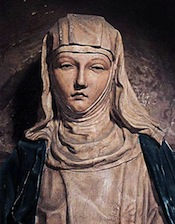St Catherine of Siena

Mystic. Dominican tertiary. Catherine was born in 1347, the youngest of about 20 children of a Sienese dyer, Giacomo Benincasa. From a very early age she was very prayerful and refused to consider marriage. In around 1367 she joined the Dominicans, still living at home and spending much of her time in prayer. She underwent many religious experiences, frequently experiencing visions of Jesus.
Gradually a group formed round her, of lay people and religious, young and old. One was an Austin Friar, from England, William Flete. They became her 'family' or 'fine troop', the Caterinati' who followed her when she began to travel around the country. She spent much of her time caring for the sick. During the plague years she visited many sick and dying people in their homes, dug graves and assisted with burials.
In 1375 she mediated in the war between Florence and other city states and the papal government. This took her to Avignon and Pope Gregory XI. She begged him to return to Rome, which he did. His successor Urban VI was immediately opposed by a rival Pope - beginning the 'great schism' that rent western Christianity for 40 years. Catherine threw herself into the struggle on behalf of Pope Urban. He called her to Rome and often consulted her. In the midst of the turmoil she died in 1380.
Although her role in church politics was important, her significance as a saint lies much more with her personal holiness, her compassion and concern for the salvation of all. Many of her letters survive, revealing a passionate and outspoken character. She often wrote to the Pope with a mixture of respectfulness and familiarity. Among her correspondents was Sir John Hawkwood, from Essex. Her Dialogue on men's religious and moral problems and duties is an Italian classic now available in English. St Catherine was canonised in 1461. She was made a Doctor of the Church in 1970. She is Patron Saint of Europe.
Watch Bishop Robert Barron's film on St Catherine: www.wordonfire.org/siena/#watch












